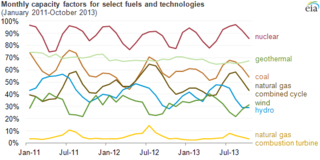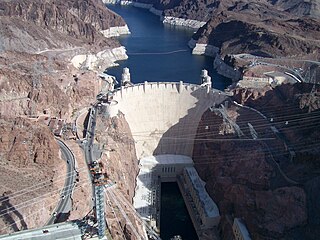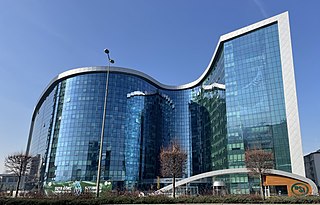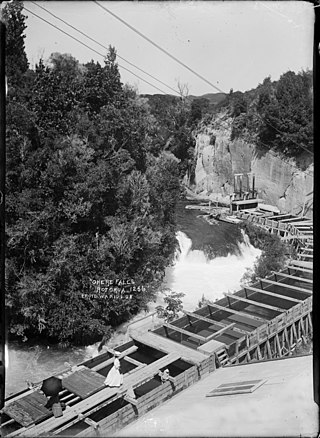Related Research Articles

Electricity generation is the process of generating electric power from sources of primary energy. For utilities in the electric power industry, it is the stage prior to its delivery to end users or its storage, using for example, the pumped-storage method.

Hydropower, also known as water power, is the use of falling or fast-running water to produce electricity or to power machines. This is achieved by converting the gravitational potential or kinetic energy of a water source to produce power. Hydropower is a method of sustainable energy production. Hydropower is now used principally for hydroelectric power generation, and is also applied as one half of an energy storage system known as pumped-storage hydroelectricity.

In electricity generation, a generator is a device that converts motion-based power or fuel-based power into electric power for use in an external circuit. Sources of mechanical energy include steam turbines, gas turbines, water turbines, internal combustion engines, wind turbines and even hand cranks. The first electromagnetic generator, the Faraday disk, was invented in 1831 by British scientist Michael Faraday. Generators provide nearly all the power for electrical grids.

A power station, also referred to as a power plant and sometimes generating station or generating plant, is an industrial facility for the generation of electric power. Power stations are generally connected to an electrical grid.

Pumped-storage hydroelectricity (PSH), or pumped hydroelectric energy storage (PHES), is a type of hydroelectric energy storage used by electric power systems for load balancing. A PHS system stores energy in the form of gravitational potential energy of water, pumped from a lower elevation reservoir to a higher elevation. Low-cost surplus off-peak electric power is typically used to run the pumps. During periods of high electrical demand, the stored water is released through turbines to produce electric power.

Hydroelectricity, or hydroelectric power, is electricity generated from hydropower. Hydropower supplies one sixth of the world's electricity, almost 4,500 TWh in 2020, which is more than all other renewable sources combined and also more than nuclear power. Hydropower can provide large amounts of low-carbon electricity on demand, making it a key element for creating secure and clean electricity supply systems. A hydroelectric power station that has a dam and reservoir is a flexible source, since the amount of electricity produced can be increased or decreased in seconds or minutes in response to varying electricity demand. Once a hydroelectric complex is constructed, it produces no direct waste, and almost always emits considerably less greenhouse gas than fossil fuel-powered energy plants. However, when constructed in lowland rainforest areas, where part of the forest is inundated, substantial amounts of greenhouse gases may be emitted.

Peaking power plants, also known as peaker plants, and occasionally just "peakers", are power plants that generally run only when there is a high demand, known as peak demand, for electricity. Because they supply power only occasionally, the power supplied commands a much higher price per kilowatt hour than base load power. Peak load power plants are dispatched in combination with base load power plants, which supply a dependable and consistent amount of electricity, to meet the minimum demand.

Kruonis Pumped Storage Plant is a pumped storage hydroelectric power plant located near Kruonis, Lithuania, 34 km (21 mi) east of Kaunas. Its main purpose is to provide grid energy storage. It operates in conjunction with the Kaunas Hydroelectric Power Plant. During periods of low demand, usually at night, Kruonis PSHP raises water from the lower Kaunas reservoir to the upper one using cheap surplus energy. The station is designed to have an installed capacity of 1,600 MW but only four 225 MW generators are currently operational. With a fully filled upper reservoir the plant can generate 900 MW for about 12 hours.

The net capacity factor is the unitless ratio of actual electrical energy output over a given period of time to the theoretical maximum electrical energy output over that period. The theoretical maximum energy output of a given installation is defined as that due to its continuous operation at full nameplate capacity over the relevant period. The capacity factor can be calculated for any electricity producing installation, such as a fuel consuming power plant or one using renewable energy, such as wind, the sun or hydro-electric installations. The average capacity factor can also be defined for any class of such installations, and can be used to compare different types of electricity production.

The Silahtarağa Power Station was a coal-fired generating station located in Istanbul Turkey. The Ottoman Empire's first urban-scaled power plant, it was in use from 1914 to 1983. The site has since been converted into a university campus for the Istanbul Bilgi University and houses two museums and several facilities. It was refurbished and renamed SantralIstanbul in 2007.

Sangtuda 1 Hydroelectric Power Plant is a hydroelectric power plant, located on the Vakhsh River in Tajikistan. Construction commenced during the Soviet period in the 1980s, but halted in the beginning of the 1990s due to lack of financing when the station was about 20% complete. An agreement with Russia allowed to restart the construction, with four units entering service in 2008–2009. The plant was officially commissioned on 31 July 2009. Once working at full capacity, the plant will provide around 12% of Tajikistan's electricity output.

Hydroelectricity is, as of 2019, the second-largest renewable source of energy in both generation and nominal capacity in the United States. In 2021, hydroelectric power produced 31.5% of the total renewable electricity, and 6.3% of the total U.S. electricity.

Energy in Greece is dominated by fossil gas and oil. Electricity generation is dominated by the one third state owned Public Power Corporation. In 2009 DEI supplied for 85.6% of all electric energy demand in Greece, while the number fell to 77.3% in 2010. Almost half (48%) of DEI's power output in 2010 was generated using lignite. 12% of Greece's electricity comes from hydroelectric power plants and another 20% from natural gas. Between 2009 and 2010, independent companies' energy production increased by 56%, from 2,709 Gigawatt hour in 2009 to 4,232 GWh in 2010.

The Naghlu Dam is a gravity dam on the Kabul River in Surobi District of Kabul Province in Afghanistan. It is located 40 km (25 mi) east of the nation's capital Kabul. The primary purpose of the dam is hydroelectricity production. The dam supports a power station with a design capacity of 100 MW of electricity. It is connected to the national grid, and is the largest power plant in the country. It provides electricity to about 100,000 households in the Kabul region.

Hydroelectricity is a major source of electricity in Turkey, due to its mountainous landscape and many rivers. The country's main river basins are the Euphrates and Tigris. Over 700 hydropower plants have been built, and they make up about 30% of the country's electricity generating capacity. Annual generation varies greatly, and in rainy years lots of hydroelectric power can be generated. Government policies have generally supported building dams, but some are controversial in neighbouring countries, and some raise concerns about damage to the environment and wildlife.

Okere Falls Power Station is a hydroelectric power station that came into production in May 1901, bringing electricity to Rotorua. At the time, Rotorua was only the fourth town in New Zealand to have electricity. The power station was the first power station built by the New Zealand government, and it remained in operation until 1936.

Renewables supply a quarter of energy in Turkey, including heat and electricity. Some houses have rooftop solar water heating, and hot water from underground warms many spas and greenhouses. In parts of the west hot rocks are shallow enough to generate electricity as well as heat. Wind turbines, also mainly near western cities and industry, generate a tenth of Turkey’s electricity. Hydropower, mostly from dams in the east, is the only modern renewable energy which is fully exploited. Hydropower averages about a fifth of the country's electricity, but much less in drought years. Apart from wind and hydro, other renewables; such as geothermal, solar and biogas; together generated almost a tenth of Turkey’s electricity in 2022. Türkiye has ranked 5th in Europe and 12th in the world in terms of installed capacity in renewable energy. The share of renewables in Türkiye’s installed power reached to 54% at the end of 2022.

Kadıncık 1 hydroelectric plant, is a privately owned hydroelectric power station located in Mersin Province, Turkey.

Pamukluk Dam is a hydroelectric plant in Mersin Province, southern Turkey. Currently, it is under construction and about 84 percent of the construction has already been completed.
The Moukoukoulou Dam is a hydroelectric dam on the Bouenza River in the Republic of the Congo, built by Chinese technicians and commissioned in 1979 to supply energy to Pointe-Noire. It is the main source of power to the south of the country. Due to fluctuating water levels and to poor maintenance of the plant and transmission network it often delivers far less than its nominal 74 megawatts.
References
36°56′23″N34°53′29″E / 36.93972°N 34.89139°E